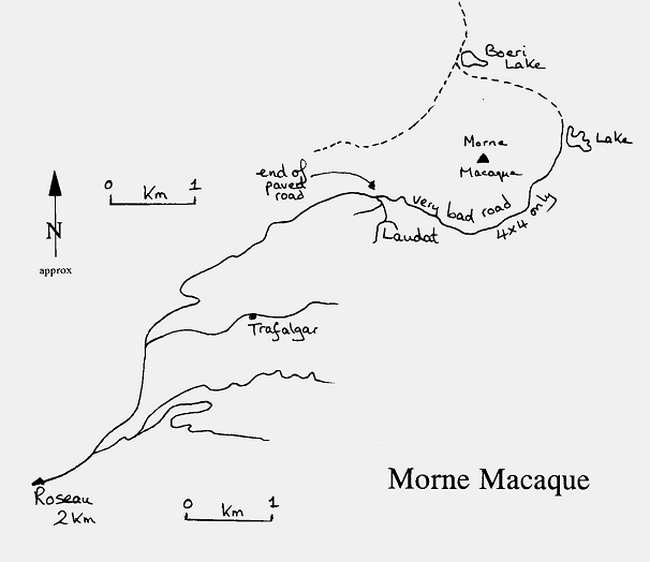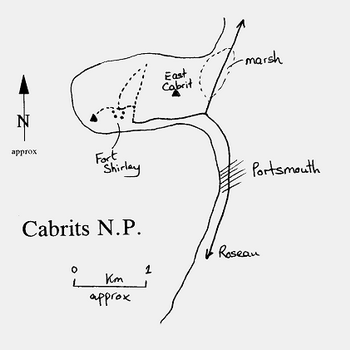Section 1 - Introduction, logistics, itinerary and general information.
Section 2 - Birding sites (Martinique).
Section 3 - Birding sites (Guadeloupe).
Section 4 - Birding sites (Dominica).
Section 5 - Birding sites (St. Lucia).
Section 6 - Annotated checklist.
Dominica
Both single-island endemics on Dominica are endangered parrots; Imperial Parrot and Red-necked Parrot. The only other restricted-range species is the Blue-headed Hummingbird which otherwise occurs only on Martinique. As all three can be found in the same area, birding efforts can be concentrated on the forest slopes of Mount Diablotin in the north of the island.
Although Dominica receives relatively few tourists, accommodation is in short supply and relatively expensive. Most visitors head for the few, black volcanic sand beaches along the west coast where, consequently, most accommodation is found. We chose to stay in the Portsmouth area in the north as it appeared, from the Lonely Planet guide, to be the closest place to Mount Diablotin with reasonable accommodation. This however proved to be a big mistake for several reasons. Having tried the Portsmouth Beach Hotel and found it full, we ended at staying at Mammies on the Beach - a flea-pit, which at 40 US$/double proved to be a complete rip-off - hot, noisy, and with almost no running water. The Mango Tree restaurant in town had quite good food, but as it is evidently the main tourist eating establishment, locals are forever coming to tables offering services, begging etc.
In retrospect, as the coastal road from Roseau is reasonable, I would recommend staying somewhere nearer Roseau. It takes about 45 minutes to drive from there to the turn off for the Syndicate Estate to get to the parrots. On our second night we stayed at the Nello Inn just next to Canefield airport. At 50 US$/double this was ten-fold better - very clean, quiet and comfortable. The only minor drawback was the limited choice available in the restaurant. However, it is only a few miles to Roseau. The Green Parrot Restaurant on the sea-front in Roseau had good breakfasts and prices.
Dominica 1. Syndicate Estate. Alt. 550 m.
The slopes of Morne Diablotin in the northern highlands of the island, hold all the remaining, fifty or so pairs of the highly endangered Imperial Parrot. These birds keep to undisturbed rain forest, around 500 metres altitude. They appear to favour the northwest side of the mountain, and especially the Picard River valley behind the Syndicate Estate, which consequently offers the best opportunity for finding them. This same area is also the stronghold of the Red-necked Parrot.
Like all estates, this one is private. However, the opening of the Syndicate Nature Trail has allowed visitors the opportunity to search for these, and other birds, along a short, but well maintained trail passing through excellent forest. Three viewpoints allow narrow views into the river valley. It must be said that in contrast to the well maintained trail, the viewpoints are unkept and extremely dangerous. In order to gain a good view into the valley, there is a tendency to want to climb and hang-out over the sheer drop. It can only be a matter of time before someone falls to their death.
|
The access road to the nature trail is well marked from the main coastal road, about 10 kilometres south of Portsmouth, 45 minutes north of Roseau. Although a 4x4 is necessary to get all the way to the start of the nature trail, a normal car can be driven easily over the majority of the track, with a short walk for the final stretch. Zero the trip-meter when turning off the main road and follow the track, through banana plantations, for 6.8 kilometres, at which point the track levels off and a left turn is found. This is as far as one can get without a 4x4. At the time of our visit there was also a small arrow and the word "trail" at this turn. Follow the map above to the nature trail, where you will find a large display board of the circular Syndicate Nature Trail with the viewpoints marked. The total loop of the nature trail is about 800 metres. Whilst walking up, you should almost certainly have seen a few Red-necked Parrot flying around, and if lucky an Imperial as well. Those feeling adventurous and with time to spare, might try the steep trail to the summit of Mount Diablotin and beyond. Species such as Forest Thrush and Blue-headed Hummingbird should be found, as well as the possibility of Lesser Antillean Euphonia. Additionally, it is almost certain that Black-capped Petrel breeds somewhere on the higher slopes of this mountain, though finding them would be tricky to say the least. |
Species recorded at Syndicate Estate:
Broad-winged Hawk 3 |
Lesser Antillean Flycatcher 2 |
Dominica 2. Cabrits National Park. Alt. 0-50 m.
The dry open woodland and scrub of Cabrits National Park, situated on a rocky peninsula two kilometres north of Portsmouth in the northwest corner of the island, offers easy access and birding, and is well worth a short stop. The park attraction is the remains of Fort Shirley and the gun batteries dating back to the 1700s. The views across the bay to Mount Diablotin are quite impressive. Plumbeous Warbler occurs fairly commonly, and the habitat supposedly holds Bridled Quail-Dove, though we failed to see or hear them. The park is open daily until 17:00, though there are no barriers, and entry is free. A small drinks stand can be found at the entrance. Several trails have been cut, including one up to the 171 metre peak of West Cabrit. As the area is not large it takes no more than a couple of hours to work. |
|
Species recorded at Cabrits National Park:
Magnificent Frigatebird 2 |
Black-whiskered Vireo 4 |
Dominica 3. Morne Macaque. Alt. 800 m.
The circular hiking trail around Morne Macaque, above Roseau is supposedly good for Lesser Antillean Euphonia and Blue-headed Hummingbird - we saw neither, though we did find Forest Thrush.

The habitat is not rain forest, but rather, dense medium height scrub. From Roseau follow the roads northeast toward Fond Cani and Laudat and take the dirt road around Morne Macaque. When the going gets too bad get out and walk. The trail passes two small man-made lakes.
Species recorded at Morne Macaque:
Green Heron 1 |
Forest Thrush 2 |
Dominica 4. Other possibilities
Scott's Head at the southern tip of the island, might be a good sea-watching point, though during our visit we saw nothing other than migrant hirundines.
The sulphur springs just inland from Soufrière are quite interesting, and have reasonable amounts of dry forest with all the commoner birds. The road to the springs is marked in Soufrière, which is a few kilometres north of Scott's Head.
Dominica has many, well maintained hiking trails, any of which might prove interesting for birding. These are all marked on the Ordnance Survey map of the island.
Section 1 - Introduction, logistics, itinerary and general information.
Section 2 - Birding sites (Martinique).
Section 3 - Birding sites (Guadeloupe).
Section 4 - Birding sites (Dominica).
Section 5 - Birding sites (St. Lucia).
Section 6 - Annotated checklist.


